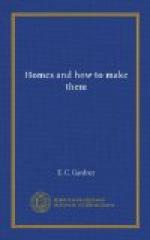Here is one advantage in wood not easily obtained in brick or stone,—the overhanging of the whole, or a part of the second story, which may be made picturesque in effect and will add much to the charm of the interior. It may be simply an oriel window swinging forward to catch the sun or a distant view, an entire gable pushing the guest-chamber hospitably forth, or the whole upper story may extend beyond the lower walls, giving large chambers, abundant closets, and cosey window-seats. Of course, such projections must be well sustained. Let their support be apparent, in the shape of massive brackets or the actual timbers of the house.
Speaking of brackets, if we could learn to think of them, wherever they occur, simply as braces, we might have better success in their treatment. Our abominable achievements in this line spring from an attempt to hide the use of the thing in its abstract beauty. The straight three by four inch braces found under any barn-shed roof are positively more agreeable to look at than the majority of the distorted, turned, and becarved blocks of strange device that hang in gorgeous array upon thousands of “ornamental” houses. Besides these there are a host of pet performances of builders and would-be architects that deserve only to be abolished and exterminated; put up, as they are, with an enormous waste of pine and painful toil of the flesh, to become a lasting weariness to the spirit. Far more satisfying and truly ornamental is it, to let the essential structure of the building be its own interpreter. Very much can be done by a skilful arrangement of the outer covering alone. Don’t try to clothe the house with a smooth coat of boards laid horizontally with no visible joints or corner finish. Such a covering is costly, defective, and contrary to first principles. Clapboards are good. Hardly anything is better, but don’t feel restricted to one mode. I send you some sketches suggesting what may be done in this department by a careful design in the use of wide boards and narrow boards, clapboards and battens; boards horizontal, vertical, and cornerwise,—any and all are legitimate, and it may be well to use them all on one building.




